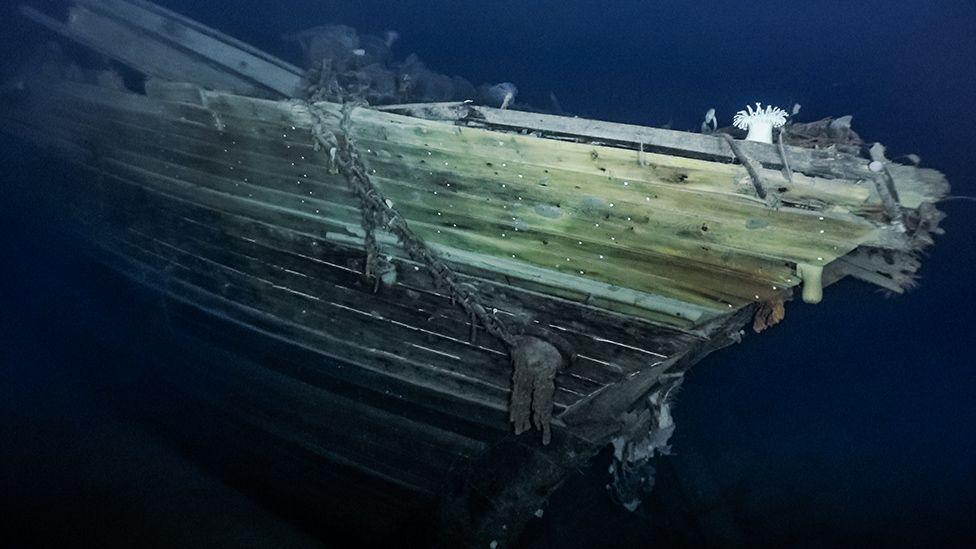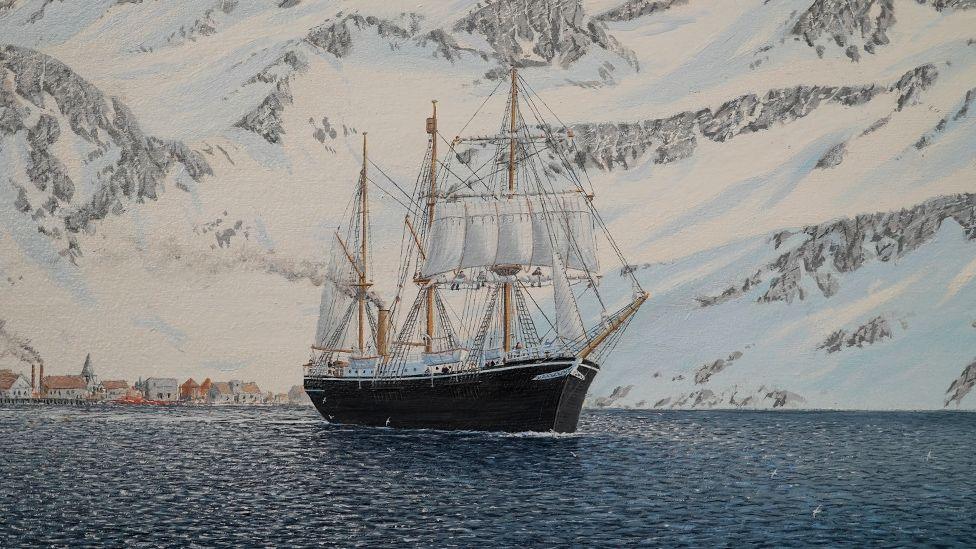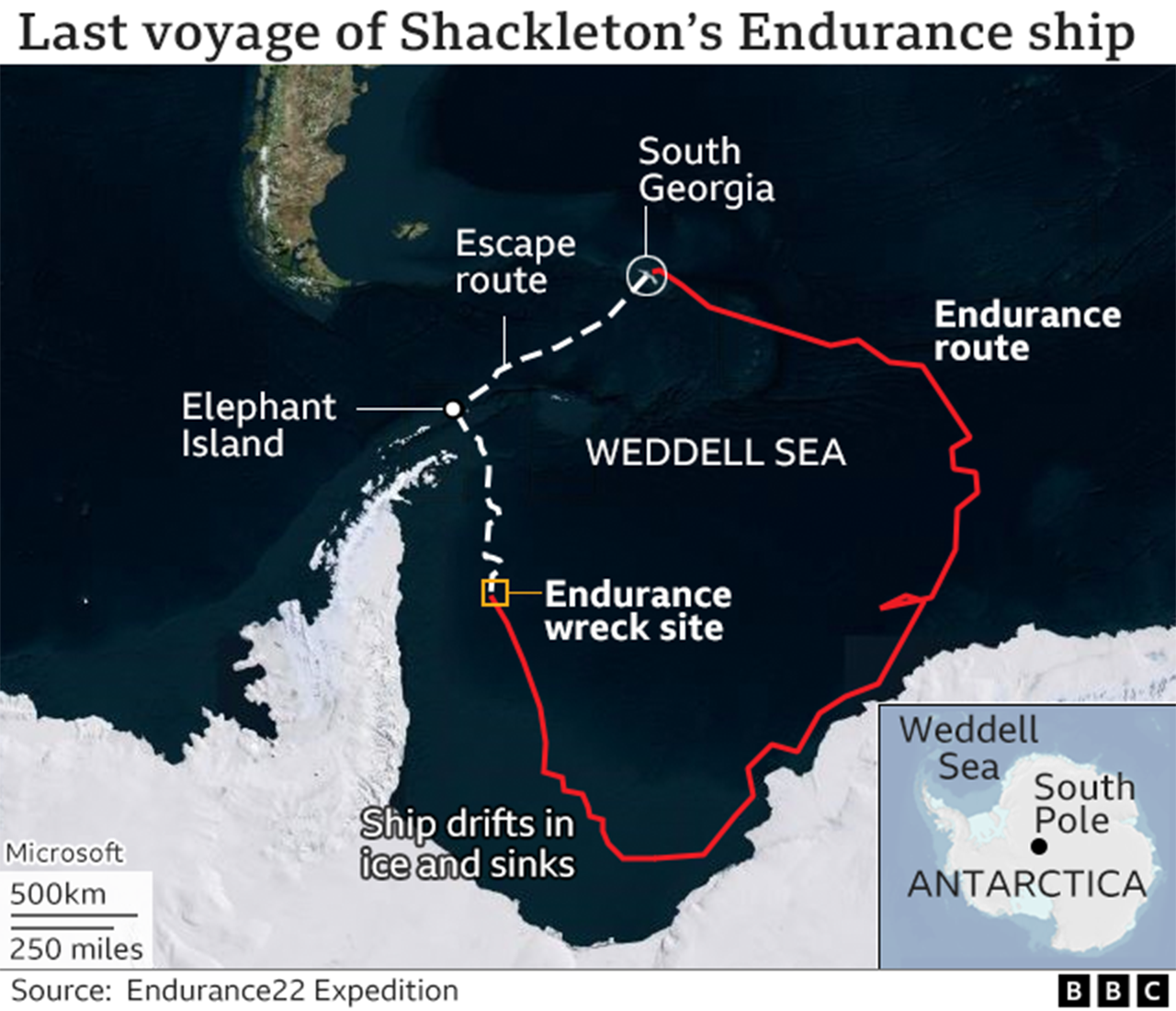Shackleton's Endurance ship gets extra protection

Endurance rests on the seafloor at a depth of 3,000m
- Published
A protection perimeter drawn around Endurance, one of the world's greatest shipwrecks, is being widened from a radius of 500m to 1,500m.
The extended zone will further limit activities close to the vessel, which sank in 1915 during an ill-fated Antarctic expedition led by celebrated polar explorer Sir Ernest Shackleton.
The measure is part of a newly published conservation management plan (CMP).
Already, no-one should retrieve or even touch objects in the protected zone.
Everything must be left in situ.
The perimeter update is a recognition that debris from Endurance - including crew belongings - may be strewn across a larger area of ocean floor than previously thought. The ship lies 3,000m down in the Weddell Sea.

Endurance set off for Antarctica from the British territory of South Georgia
"Endurance is very well protected where it is now, given its remoteness, depth and a near-permanent cover of sea-ice," explained Camilla Nichol, the chief executive of the UK Antarctic Heritage Trust, external, which drew up the CMP in partnership with Historic England, external.
"There are however considerable potential risks and it requires an international effort to make sure this wreck is not interfered with so that it can be sustained long into the future," she told BBC News.
Explorer Shackleton's last ship found on ocean floor
- Published12 June 2024
The book that records all disasters at sea
- Published7 March 2023
Shackleton's lost ship found after 107 years
- Published9 March 2022
Endurance is one of the standout symbols of the so-called Heroic Age of Antarctic exploration.
Its story has captivated the world for decades.
The ship was lost to the deep when it became trapped and holed by thick Antarctic sea-ice. How Shackleton then managed to get all his men to safety is the stuff of legend.
The discovery of Endurance on the ocean bottom in March 2022 was nothing short of a sensation.
It had been regarded as perhaps the single most difficult wreck to find anywhere on the globe.

Persistent sea-ice makes it extremely hard to reach the site of the wreck
Very few people have the expertise to visit Endurance today, but this is unlikely always to be the case.
And as the world warms and the frozen floes in the polar south continue to retreat, opportunities to access the wreck will increase.
Deep-diving technologies are certain to become more capable, which raises the worrying prospect of looting, or of crash-damage resulting from careless submersible operations. Fishing is sure to become more commonplace in the Weddell Sea and the risk of trawlers' discarded gear getting tangled in the wreck is an additional concern.

December 1914: Endurance departs South Georgia
February 1915: Ship is thoroughly ice-locked
October 1915: Vessel's timbers start breaking
November 1915: Endurance disappears under the ice
April 1916: Escaping crew reaches Elephant Island
May 1916: Shackleton goes to South Georgia for help
August 1916: A relief ship arrives at Elephant Island
The CMP, which was unanimously approved at a recent meeting of nations that are party to the Antarctic Treaty System, looks forward to how these threats can be mitigated.
An initial step is the agreement from cruise ship owners not to go anywhere near the Endurance zone.
A further step would be to boost the wreck's protection rating.
It's currently designated a Historic Site and Monument (HSM). This gives it "do not touch" status, but doesn't of itself stop anyone from approaching the vessel.
If Endurance could become an Antarctic Specially Protected Area (ASPA), plans for any visit would then be subject to a rigorous review by heritage and technical experts, and require a specific permit.

There is an enduring fascination with Shackleton and Endurance
Antarctic Treaty nations discussed ASPA designation at their recent meeting and a formal application will be pursued in 2025.
"It would be unique. There's never been an ASPA of this sort before," said Camilla Nichol.
"And, of course, there are many other wrecks in the Antarctic which are far more accessible than Endurance, so it could become a precedent."
When Shackleton's ship was finally located on the seafloor, it was seen to be in astonishingly good condition. Its timbers were pristine and its basic structure was intact.
The wreck was covered in a fascinating array of filter-feeding animals - sponges, sea anemones, sea lilies and starfish.
Marine biologists will demand to study this ecosystem further. It is, in effect, an artificial reef.

The CMP sets out guidance for future research, with the insistence that all data be made public.
The management plan identifies the huge potential to maintain and broaden interest in the Endurance story through digital technologies.
A film about the wreck's discovery is due to be released by National Geographic later this year. It should be accompanied by a 3D scan of the vessel.
"There's enormous interest in Endurance and our management plan seeks to make sure that any activity at the wreck site is in the best interests of the ship," said Hefin Meara, a marine archaeologist with Historic England.
"By putting this plan together and presenting it to the treaty parties, what we get is a way for everybody to work to a common framework with a common understanding. What we can't have at this stage is people having different views and doing completely different things."